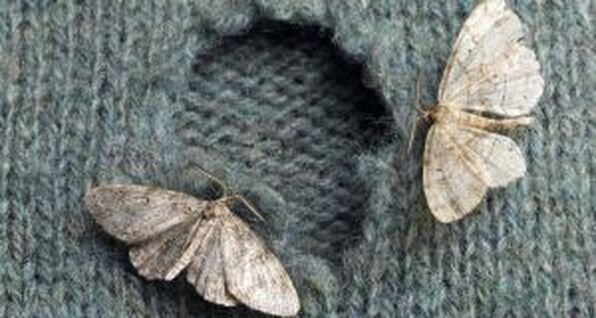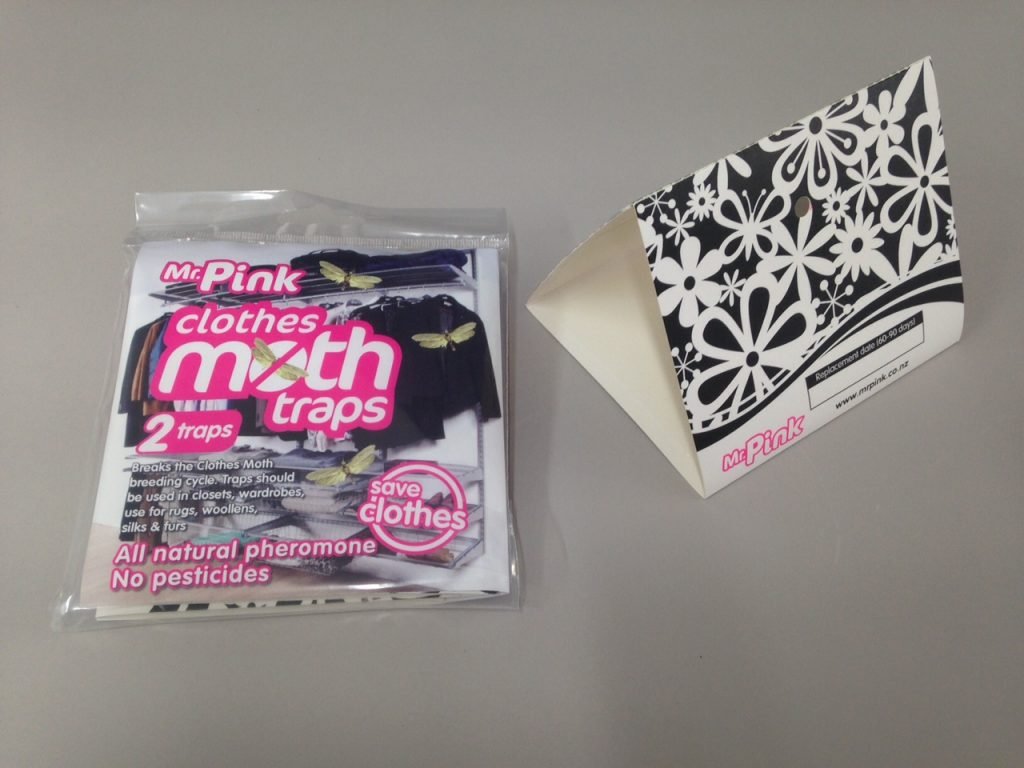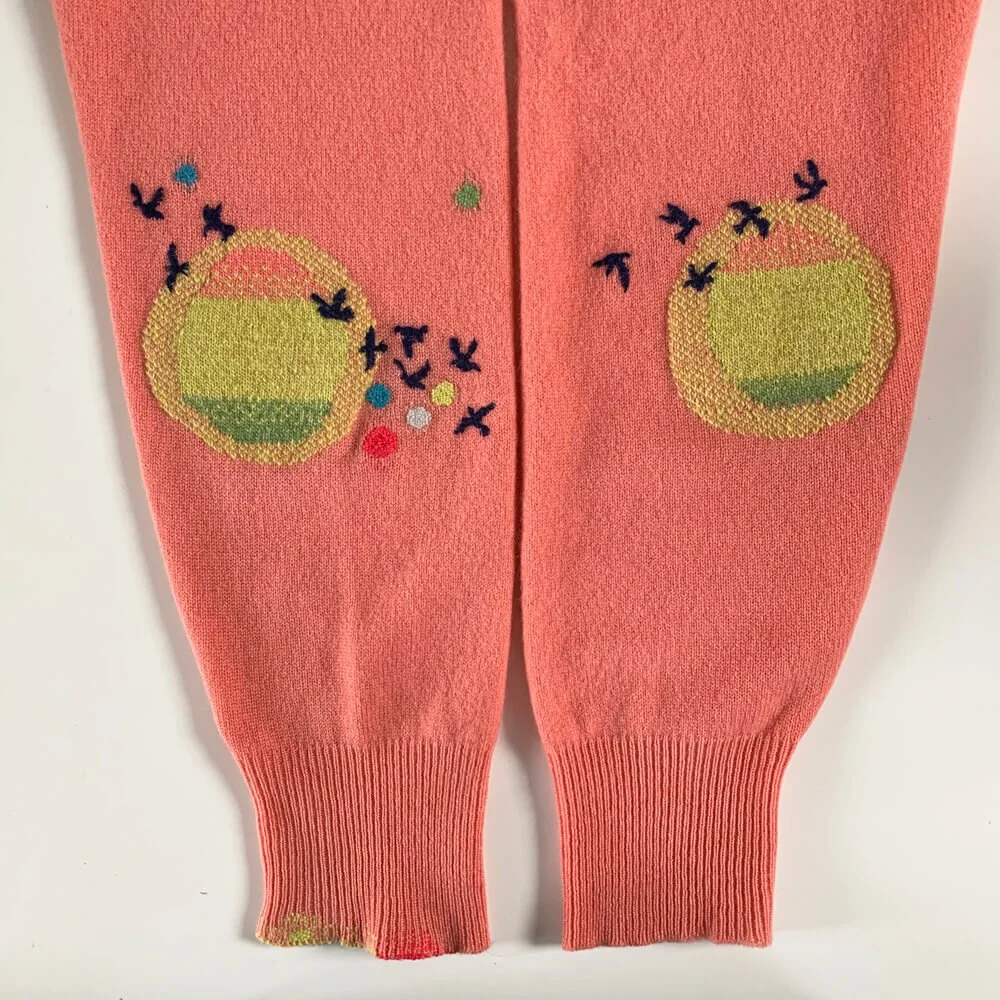Moths - Wools Mortal Enemy
Winter is here: the time when we take out our winter clothing and bring out last years yarn to finish that project. Also the time when we spot the damage that these little winged blighters have caused! Not only do they munch copious amounts of wool, but they love any protein fibre, including silk, fur, feathers, and even leather if they're really hungry. I’d wager that when unpacking your winter things, you have also unpacked some very unwelcome holes surrounded by wool. Moths seem to particularly enjoy merino skivvies, the finer the better.
Clothes moths are more active in warmer temperatures, traditionally spring and summer (when woolens are in storage), but now that houses are warmer, they often start their nibbling much sooner.
Sadly, we are very familiar with moth damage in fabrics donated to us at Stitch Kitchen, which have often been tucked away in quiet dark spaces (moth's favourite hang out) for several months. Avoiding inviting moths in; getting them out if they have gatecrashed; and dealing with the damage are regular battles we face.
Here are a few strategies to help you win your battle and save your woolens!
1. Avoiding bad dinner guests
Vacuuming
Spring (and autumn) clean Moths love quiet untouched places, and dust bunnies are like the waitstaff showing the moths to the best buffet.
You're also more likely to find signs of moths early, and prevent an infestation, if you take the time each season when you change over your wardrobe to thoroughly vacuum out wardrobe and drawers, and even wipe down walls.
Before packing clothes away, also make sure they're completely clean, to avoid offering appetizers of residual sweat and body oils etc.
Cedar chips/balls/blocks
Moths HATE the smell of cedar (it can kill young larvae), yet humans rather love it (a lot better than old noxious moth balls at least!).
You can buy purpose-prepared cedar as balls or blocks... or if you know a carpenter who has offcuts of untreated cedar, even better!
Be careful not to let them directly touch your clothes: they can leave oily spots. Wrap clothes, or the wood, in a cotton bag before placing in your drawer or wardrobe.
Top-up the wood regularly by adding cedar oil, or by lightly sanding the wood to release more of it's sweet-smelling goodness.
Pheromone-based moth traps
These are available from a number of brands at most supermarkets and hardware stores.
These are poison-free and work to attract and then trap the male moths on their sticky surface, preventing breeding and minimizing the population of hungry caterpillars!
They're good to use before you think you might have a problem, as they can be a great early warning of the presence of moths before things get too serious.
Lavender
The smell of lavender is also a big turn off for moths. Sprinkle a few drops of lavender oil onto cotton wool, or onto drawer liners.
Or you can use bags of dried lavender flowers which are regularly available from market gardens, craft shops and op-shops.
You can also grow your own lavender and sew simple cotton muslin or net bags (hint: we have a plentiful supply of net fabric at Stitch Kitchen!).
Rosemary and mint are also apparently good.
Moth-proof storage
General-purpose cardboard boxes are no deterrent to moths, so if you are storing fabrics or clothes for any length of time (e.g. not in weekly use), make sure they're well cleaned and aired and pack them into an acid-free conservation box, or sealed bag or box (or at least into a cotton or non-degradable plastic bag before putting in the cardboard box).
Add lavender or cedar to your storage boxes in case anything makes it through loose seals. This also helps keep clothes smelling good when they come out of storage.
You can make your own zip-up storage bags, from cotton or polyester or nylon. Something that won't let the pests in but won't prevent the fabrics from breathing.
2. Turning the tables
If you find evidence of moths, in traps, or on your clothes, or find holes they're left behind, it's time for further action:
Extreme temperatures can kill moths at all stages of their lifecycle. (Just be careful with things that may have laminated materials, like interfacing or PVC, which can be damaged).
Freeze fabrics or clothing by placing in a plastic bag, squeezing out the air, sealing and placing in your freezer for a minimum of 72 hours.
You can also heat fabric by wrapping your garment in black plastic bag, squeeze out the air, and place in the sun for the day, ideally on a surface that will catch the heat of the sun - like a tin garden shed roof, or a trampoline.
Best of both worlds can be to wrap, then place in the boot of your car for a week, which will go through extremes of heat and cool. ;) (Especially if you have an outside-living car that parks in a sunny spot during the day, and you scrape frost from in the morning.)
Clean, clean, and clean: launder not only the affected garments, but anything that has been in the same space, including anything synthetic. Then put your washer on a self-cleaning cycle (hottest cycle) as an added precaution.
Dry on the clothes line if you can, so the UV also helps to kill any pests.
Dry-clean only garments should only be dry-cleaned. Fortunately we have an environmentally responsible option here in Dunedin at Preens dry-cleaner (non affiliate).
Thoroughly clean your wardrobe and drawers as well, before putting clothes away again; top up cedar blocks by sanding or adding more cedar oil (or spray cedar oil directly onto the walls of your wardrobe), and/or top up lavender bags, to deter the moths coming back
Turning a flaw into a feature.
Don't be deterred from keeping and wearing a moth damaged item with pride. Yes, it has holes in its character - don't we all. But that's what makes us interesting.
Darning: darning has recently become very trendy, thanks perhaps to COVID and lockdowns giving people time to learn and appreciate the benefits of repairing clothes rather than going into a mall and buying new ones. Not sure how to do it? We can supply you with the tools to repair and jazz up your clothes, and even show you how. Bring your mending and come along to our monthly Mend & Make Awesome workshops, on the 2nd Saturday of each month (excluding January).
Patching: If the hole is too big, you can patch over it with another piece of similar-weight material. For knitwear, you can be subtle by shortening the sleeves or body and using the offcut piece to cover the hole. Or you can be bold and use pieces from a 'donor garment' that is too far gone. Patching has become very trendy with interest in the Japanese tradition of Boro. Simply put, this is layering a patch of fabric over (or under) a worn area using a series of running stitches to hold the materials together. Taking this further is Sashiko, which is creating intricate patterns with strategically placed stitching, which strengthen materials with or without patches. This works best on woven fabrics, like your favourite wool coat.
At Stitch Kitchen, we have LOADS of beautiful knitted merino fabric offcuts from local manufacturing company Glowing Sky, in a huge variety of colours, in just the right weight for merino t-shirts, leggings, tunics etc. We also have small pieces of woven wool fabrics amoung our beautifully colour sorted scrap boxes. Come in and check it out! Be bold! Have fun!
We run beginner friendly visible mending workshops, including teaching Boro-style mending, on a regular basis, taught by Dunedin textile artist Kate Watts (check her out on instagram).







